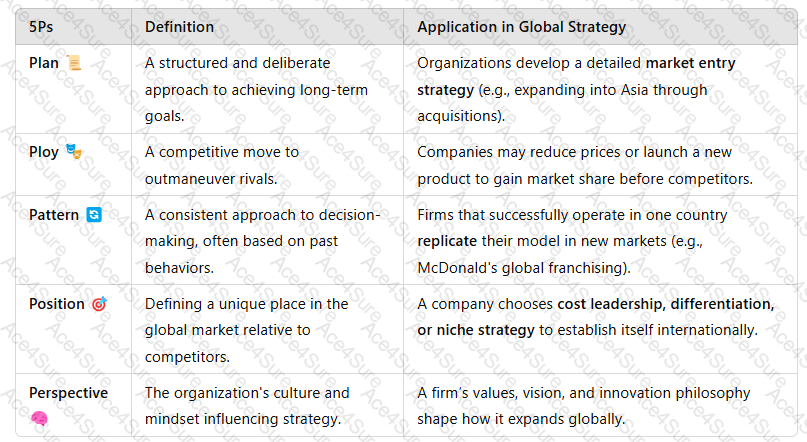Mintzberg’s 5Ps and Global Strategy Development
Introduction
Henry Mintzberg’s 5Ps of Strategy is a framework that helps organizations understand the multiple perspectives of strategy. It recognizes that strategy is not just a planned activity but evolves through deliberate and emergent actions. The 5Ps—Plan, Ploy, Pattern, Position, and Perspective—help organizations develop an effective global strategy by providing a structured approach to decision-making and competitive positioning.
1. Explanation of Mintzberg’s 5Ps
Mintzberg’s 5Ps define strategy in five different ways, which help in shaping an organization’s global expansion and competitive positioning.
 A screenshot of a computer
Description automatically generated
A screenshot of a computer
Description automatically generated
2. How Mintzberg’s 5Ps Assist in Developing Global Strategy
1. Strategy as a Plan????– Setting a Clear Direction for Global Expansion
Organizations develop structuredstrategic plansfor international growth, includingmarket research, investment strategies, and risk assessments.
Example:Teslaplanned itsglobal expansion into Chinaby building a Gigafactory, ensuring supply chain efficiency and market entry success.
✅Benefit:Ensures a structured, well-researched approach to global expansion.
2. Strategy as a Ploy????– Gaining Competitive Advantage
Companies use strategic moves toblock competitors or gain an early advantagein global markets.
Example:Amazon strategically enters new marketsbyoffering discountsandacquiring local businessesto weaken competitors.
✅Benefit:Helps organizations counter competition andestablish dominance in new markets.
3. Strategy as a Pattern????– Replicating Successful Models
If a company has aproven business model, it canapply the same strategyacross different regions.
Example:McDonald's follows a pattern-based global expansion model, using standardized menus but adapting products to local tastes (e.g., McAloo Tikki in India).
✅Benefit:Allows organizations toscale efficientlywhile maintaining consistency.
4. Strategy as a Position????– Establishing a Competitive Market Position
Organizations must decide how they willcompete globally—whether throughcost leadership, differentiation, or niche markets.
Example:Apple positions itself as a premium brandworldwide, maintaining exclusivity through high pricing and innovation.
✅Benefit:Helps organizations create adistinctive identityin international markets.
5. Strategy as a Perspective????– Aligning Culture and Global Vision
A company’sculture and values influenceits global strategy.
Example:Patagonia’s sustainability-first approachshapes its expansion into environmentally conscious markets, aligning with global CSR expectations.
✅Benefit:Ensures global expansion aligns with thecompany’s long-term values and mission.
3. Advantages of Using Mintzberg’s 5Ps in Global Strategy Development
✅Holistic Approach– Ensures strategy isnot just a rigid planbutadapts to competition and market trends.✅Enhances Competitive Agility– Organizations canpivot between strategies(e.g., using a Ploy to disrupt competitors).✅Supports Market Adaptation– Helps companies applyPattern-based expansionwhile considering local market needs.✅Aligns Corporate Vision with Market Positioning– ThePerspective approachensures expansion aligns with organizational values.
4. Limitations of Mintzberg’s 5Ps in Global Strategy
❌Lack of Emphasis on External Factors– UnlikePESTLE or Porter’s Five Forces, the 5Ps focusmainly on internal strategy.❌Can Be Overly Conceptual– Maylack specific actionable stepsfor implementing global expansion.❌Does Not Account for Rapid Market Changes– Infast-changing industries(e.g., tech), rigid strategic planning maybecome outdated quickly.
????Solution:Combine5Ps with external analysis tools(e.g., PESTLE for macro-environmental risks, BCG for product portfolio management).
Conclusion
Mintzberg’s5Ps of Strategyprovide acomprehensive frameworkfordeveloping global strategies, ensuring that businesses considerplanning, competitive moves, consistency, positioning, and cultural alignment. However, it should be usedin combination with other strategic modelsfor a well-rounded approach toglobal expansion and decision-making.